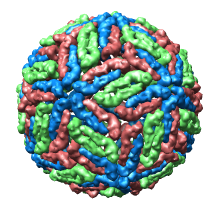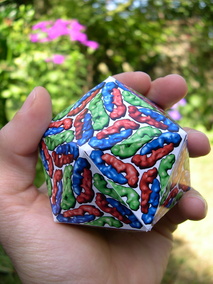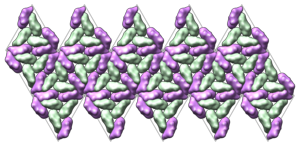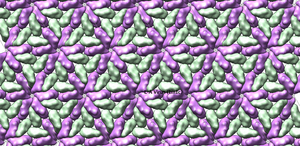


February 27, 2007

| 
| 
|
| Dengue virus 1k4r | Flattened | Paper model |
This tool flattens an icosahedral virus capsid multiscale model. The 20 triangles making up the icosahedral capsid are layed out in a plane. The flat view can be printed and folded into a paper icosahedron model.

Use menu entry Tools / Higher-Order Structure / Flatten Icosahedron to display the flattening dialog. After opening he icosahedral multiscale model press the Flatten button. The Unflatten button will restore the icosahedral layout.
Retrieve coordinates for Dengue virus, 1k4r, from the VIPERdb web site. Open the PDB file in Chimera. Start the multiscale tool, menu entry
Tools / Higher-Order Structure / Multiscale ModelsSelect multimer type Icosahedral symmetry, xyz 2-fold axes (VIPER) at the bottom of the multiscale dialog and press the Make models button.
Display the flattening dialog with menu entry
Tools / Higher-Order Structure / Flatten Icosahedronand press the Flatten button.
Here is a 5 inch by 10 inch, 300 dpi flattened 1k4r image suitable for printing. The model picture above was made in about 30 minutes by printing this image on photo paper, cutting, folding and taping.
The spacing of the icosahedron triangle faces in the plane depends on the radius parameter. The radius controls how closely spaced the triangles are in the plane. Triangles of an icosahedron of the given radius would be arranged so the triangles pack with no overlap and no gaps in the plane. If the Flatten button is pressed with no radius specified, then the maximum radius of the shown virus capsid model will be used, that is the distance from the origin to the most distant atom.
The show triangle mesh switch shows displays the edges of the triangles for the flattened icosahedron. These can be used as cutting and folding lines for making printed paper models. The mesh color can be set. The mesh is positioned according the the icosahedron radius. The mesh can be raised above the multiscale surfaces so it is not obscured by setting a positive z offset. Press the Enter key after changing the z offset to move the mesh.
When saving an image of the flattened icosahedron for constructing a paper model it is important to set the Chimera camera to display using orthographic projection instead of the default perspective projection. If the default perspective camera projection is used the triangles near the edge will be larger than those near the middle due to fish-eye type perspective distortion. This switch is the same as the one on the Chimera camera dialog (menu Tools / Viewing Controls / Camera).

| 
|
| L-A virus flattened. | Tiled image. |
Cutting and folding to make a paper model chops away parts of proteins that stradle triangle boundaries. To see full proteins in the paper model you can tile the image so parts of a cut protein will appear on both sides of the cut lines when taped together. This isn't necessary but improves the appearance of the taped together model.
Chimera does not currently do the tiling so you do this by hand in a photo editing program. I used GIMP for the L-A virus example shown. Create a flat icosahedron image in Chimera with a transparent background. Then import it into the image processing program and make 4 copies of the image and place them around the border of the original image. In GIMP this is done using "duplicate layer" and the "move layer" mouse mode.
To make a Chimera image with a transparent black background use the "Transparent background" option in the Viewing Effects panel (menu entry Tools / Viewing Controls / Effects) in Chimera version 1.2251 or newer. In older versions of Chimera this option had to be enabled when starting Chimera using the --bgopacity command-line option. Only high end graphics cards support this feature. If it is not available you can probably make the background transparent in a photo editing program such as GIMP or PhotoShop.
The "stacking order" of the image copies when tiling sometimes effects the appearance. I placed the 4 surrounding copies below the original image. The resulting tiling is not perfect. Along the border between the original image and a copy some places may need to be above and some below the original image. The only practical way to get this interleaving right is to tile in Chimera in three dimensions -- which is not yet supported.
Planar arrangement. Each chain of the multiscale model is associated with the nearest triangle of an icosahedron in a standard reference frame. The nearest triangle is the one whose center is closest to the geometric center of the chain (unweighted average of all atom coordinates). The chains associated with a triangle are transformed as a group by a common rotation and translation to the planar arrangement.
Icosahedron reference frame. This tool uses the icosahedral reference frame where 2-fold axes are along x, y and z axes, called "Icosahedral symmetry, xyz 2-fold axes (VIPER)" in the multiscale dialog. To use a different reference frame requires a small change to the flattening Python code. Specifically you would change the '222' in file share/FlattenIcosahedron/__init__.py to '222r', or '2n5', or '2n3'. Refer to file share/Icosahedron/__init__.py for the definitions of these alternate reference frames.
Multiscale models only. This tool will only flatten models created with the Multiscale Models tool. It will not work on plain PDB models even if they contain chains forming an icosahedron.
Multiple models. If more than one multiscale model is opened, then all of them are flattened. There is currently no way to choose a specific model.
February 27, 2007. Updated for Chimera version 1.2348 which uses NumPy instead of Numeric Python.
June 14, 2006. Added explanation of how to tile flattened virus to handle proteins that stradle cut lines.
May 2, 2006. Added triangle mesh display and orthographic projection option to make it easier to create paper model.
April 4, 2006. Original version created following suggestion of Padmaja Natarajan.